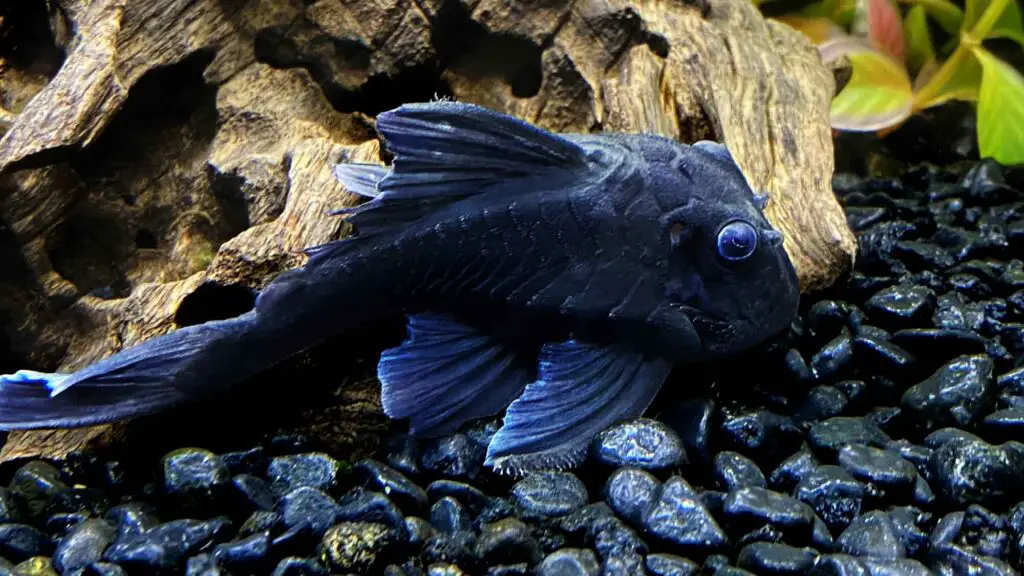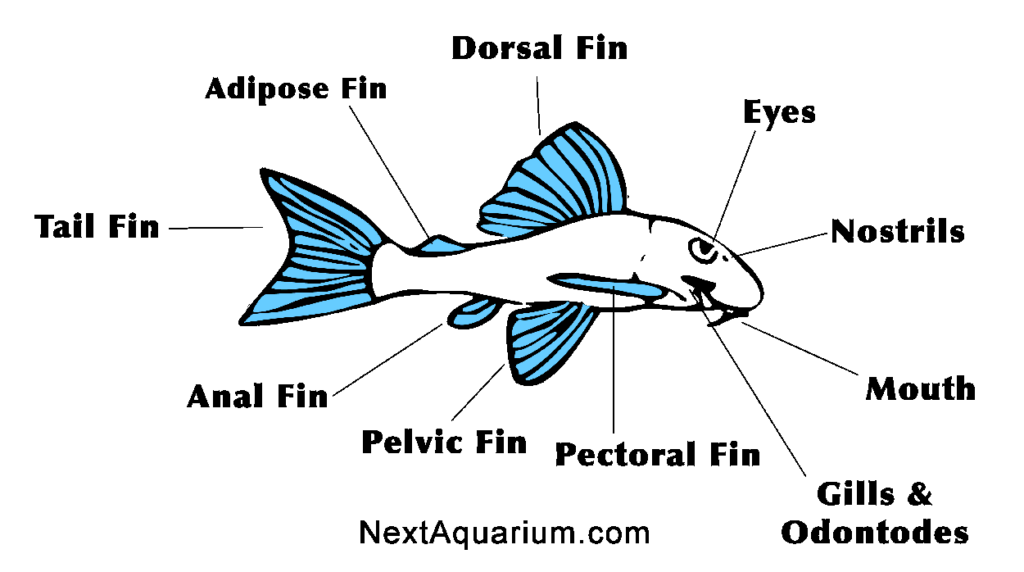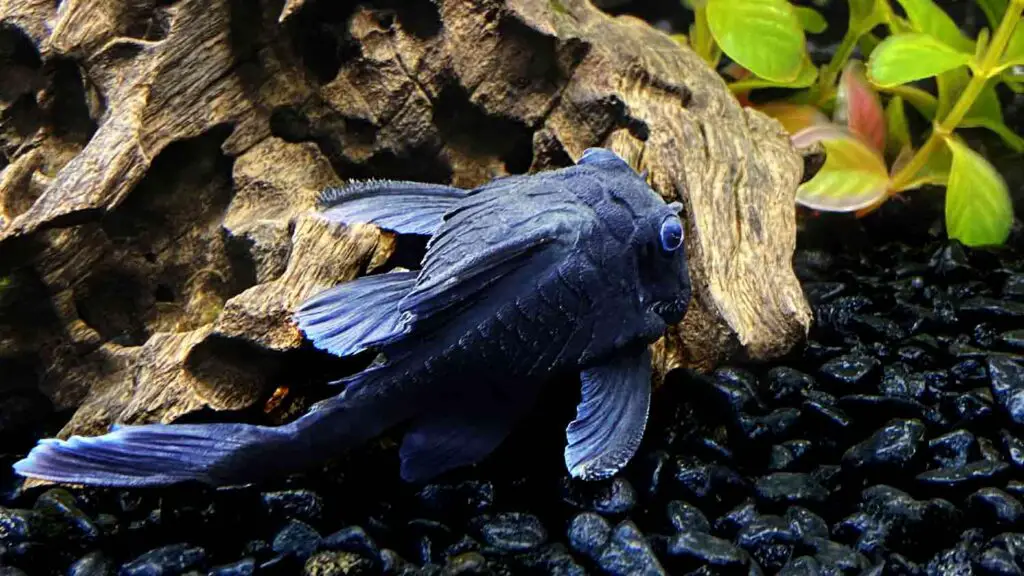The L239 Blue Panaque (Baryancistrus beggini) is a freshwater fish that is highly sought after by aquarists all over the world. Since Blue Panaque Pleco are easy to keep, they are an excellent choice for the majority of aquarists of all skill levels. They are highly tolerant to a broad spectrum of tank conditions and may live happily in your tank with just a little attention. They require a certain aquarium setup and environment to thrive.
This guide on Blue Panaque Pleco Care will provide you with all the information you need about this species.
Species Profile & Overview
Blue Panaque ( L239 Pleco ) is naturally found in different places in the Río Ventuari and Río Orinoco in Venezuela. They are also found in parts of Colombia. This fish is mainly exported from Colombia and are now amiable in many countries around the world.
They have bulky body that has dark blue color with no apparent markings or stripes. Their bony back and dark coloration will help them avoid being seen and eaten by aquatic predators in the wild.
This species of pleco is not as widely available in pet shops and only becomes available when it’s pleco collecting season in Venezuela and Colombia. When compared to common plecos, this makes them relatively expensive.
A large majority of the Blue Panaque plecos sold in the United States and Canada are wild-caught. This is because wild-caught specimens are often less expensive than those bred in commercial facilities.
We hope that the increased interest in this fish encourages commercial fisheries to focus on breeding this fish to prevent population loss in its natural habitat.
Appearance:

The Blue Panaque Pleco has a plain and lovely dark blue color. Their entire body is coated in a dark blue color and lacks any spots or patches. The only visible pattern you might notice is the pattern that is created as a result of the bone plates on their back.
As can be seen in the image, their exterior anatomy is identical to that of other plecos. Below the skull, they have their suckermouth that is in line with their soft belly. Their mouth is the primary means of attachment to objects.
The head and midsection are very broad, but the rest of the body tapers down as it moves toward the tail. This makes them slightly different and unique from other plecos.

The fins are solid in color and unpatterned to match the rest of the body. Same as other plecos they have a large dorsal fin but what sets them apart is their large blue eyes that are popped out of their head. Fins and eyes are the only soft spots they have on their back.
Adult Size
The average Blue Panaque Pleco Size is 3.5 inches. They are one of the smallest types of plecos you can buy. If you have a smaller tank and still want a unique pleco to keep this is probably the ideal pleco for you.
Lifespan
The L239 Blue Panaque Lifespan is approximately 8 years. Under the right tank condations and proper diet they will live even longer.
To ensure your fish live its full expected life you must insure your tank has clean water at all times. At the same time food is super important to increase thier life expectancy. With the right diet and tank parameters you can expect this fish to live its full expected lifespan and may even cross and live longer.
Behavior and Temperament
The Blue Panaque Pleco’s calm demeanor makes it a wonderful addition to a community tank. As is the case with the vast majority of pleco species, these fish come out of hiding at night. this is the time they are the most active and search for food. But the Blue Panaque seem to be more outgoing fish and more often come out of their hiding spot in the daytime.
When compared to females, males exhibit higher levels of territoriality and aggression. Having many males in your tank might lead to fights. Males will compete with one another over territory and caves in the aquarium. Having one cave per each pleco is the ideal way of reducing aggression among L239.

Blue Panaque Pleco Care
Blue Panaque Pleco care is easy and anyone can keep them. They require little attention and are hardy enough to adapt to your tank conditions. In general, they are easy-to-care fish that anyone can keep; as long as their tank has parameters that fall within the range L239 can handle.
Clean and warm water and a good diet are necessary to keep this fish healthy. As long as you take care of their needs, you shouldn’t face any problems! Here are some maintenance tips to keep your L239 Pleco in good health and happiness.
Tank Size
An adult Blue Panaque Pleco will need a tank size of at least 30 gallons or more. This fish grows to only 3.5 inches so a 30-gallon tank can make a great home for it. These fish are often sold as adults so you may not need to upgrade your tank along the way.
When it comes to plecos, we always recommend getting the biggest aquarium you can afford to house. A large tank makes it easy to care for L239 and make your job easier when it comes to stocking your tank.
Tank Setup:
For the well-being of the Blue Panaque Pleco, it is essential to recreate its native environment. Driftwood, boulders, debris, and a soft river bed characterize the rivers this fish came from. If you create a habitat like this for your L239 pleco, they will feel more at ease and at home.
Having natural decorations like driftwood and rocks can also aid in keeping the water’s characteristics in check. The L239 pleco lives in softer waters in the wild so having a few driftwood will help your tank to have lower ph levels. At the same time, if you stock the aquarium with an adequate amount of rocks and driftwood, your pleco will have plenty of places to hide and will feel more secure.
The Blue Panaque Pleco also needs pleco caves. This is especially true for male specimens. Caves will prevent the pleco to get stressed.
The substrate of the aquarium should also be carefully considered. These bottom-dwelling fish have a very soft belly and can easily hurt if you have sharp substrates. The optimum substrate for l239 plecos is sand, however, small pea gravels might also work.
In addition, planted aquarium substrates are also a great choice as they are often soft and won’t hurt the fish. Having this type of substrate will also help you with keeping live plants and make a more natural living environment for your fish. Plants will also keep your tank clean while providing your fish with enough hiding spots.
Water Parameters:
Blue Panaque Pleco prefers warmer waters that are slightly acidic. They need stable water conditions with no to few fluctuations. Your main goal should be to keep your tank stable and to keep your tank clean at all times. They also prefer to have moderate water movement in the tank so a powerhead might be necessary.
The good news is that these fish are quite resilient and can handle a wide variety of water parameters. The range of parameters the l239 pleco can handle is wide which makes keeping them easier. Making an environment similar to their natural home in the tank will benefit the fish the most.
The following specifications for the aquarium in which L239 Plecos can be kept are recommended:
- Temperature: 74 – 85 Degrees Fahrenheit
- PH: 5.5 – 7.5
- TDS: 80 – 180 PPM
Maintaining your aquarium within the aforementioned parameters will guarantee the health and well-being of your fish.
By using a Total Dissolved Solids (TDS) meter, you can determine the exact concentration of dissolved substances in the water of your aquarium.
When the TDS in your tank rises beyond the recommended level, you must change the water to bring it back down to normal levels.

Lighting:
Blue Panaque Pleco, in general, thrives in dim light conditions. But they can also live in bright lighting conditions if you have a few shaded areas where they can hide.
Because we always recommend having plants in your pleco tanks, you will also need brighter lights so your plant can grow. So you need to follow the recommendations we made in the “Tank Setup” section of this guide to make hiding spots for this fish. Your L239 Pleco will require extra caves, decorations, and other places to hide when the lights are on.
Filter System:
The Blue Panaque Pleco requires a well-established tank with a strong filtration system. The tanks have to be well-oxygenated as well to help the beneficial bacteria to grow.
Your fish can easily get sick if the water isn’t kept in perfect condition. A good filter will help your tank to remain clean and healthy at all times. Your fish run the risk of contracting different diseases both internally and externally if the water is not clean.
Common Diseases and Prevention
Blue Panaque is at risk of all common aquarium diseases but they don’t have species-specific diseases that only affect them. Just like any other aquarium fish, they’re susceptible to disease if the living conditions in their tank aren’t right.
They are also highly susceptible to any of the usual illnesses that other fish may introduce to your aquarium. So never add new fish to your tank without properly quarantining it. It is very common for pet stores to have some kind of disease in their tanks as they constantly bring in fish.
by following the best practices we recommend in this guide, your l239 Blue Panaque should not face any issues or illnesses. These fish are very hardy and show no sign of illness if you keep them in optimum conditions. At least this is what we personally experience with these fish in our tanks.
Diet and Feeding Requirements
Blue Panaque Pleco are omnivores that will chow down on just about any kind of fish food you toss at them. Their primary diet should be plant-based, but they should also receive meaty foods sometimes.
Occasionally, they may even consume some of the tank’s naturally occurring algae and biofilm. However they aren’t the most efficient algae eaters, thus you may want to add some algae-eating fish to your aquarium if you have an algae problem.
There are a variety of commercially prepared foods formulated especially for plecos that you can feed your L239. These foods have most of the components your fish needs to thrive. But shouldn’t be the only food you give them.
Plants and algae should make up the bulk of L239 Pleco’s diet but they should also receive protein in their diet. You can feed your pleco any sinking foods that are plant-based. Algae wafers and shrimp wafers can be great sources of food. you can also feed them frozen foods like bloodworms, tubifex, brine shrimp, and daphnia.
High protein foods should be given as snacks once or twice a week while dry foods should be the main diet your Blue Panaque pleco receives daily. The ideal time to feed L239 is at night.
Tank Mates
Blue Panaque Pleco is able to coexist in community aquariums with most aquarium fish. They are very passive species and will not harm other fish. however, other large species might bully your pleco so try to keep them with similar-sized fish that can live in the same range of water parameters.
Fish like African cichlids that need high pH levels or aggressive fish like piranhas are not ideal tank mates for L239 Plecos. To help get you started, here are a few tank mate ideas for your Blue Panaque Pleco:

Conclusion
If you want a low-maintenance freshwater fish, the Blue Panaque Pleco is a great option. The calm demeanor and low maintenance requirements of this species have made it a favorite of aquarium keepers. As a result of their eye-catching appearance, in our opinion, they are one of the top plecos to keep in your tanks.